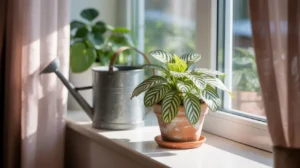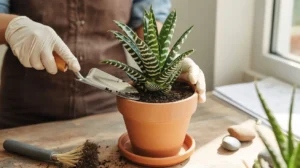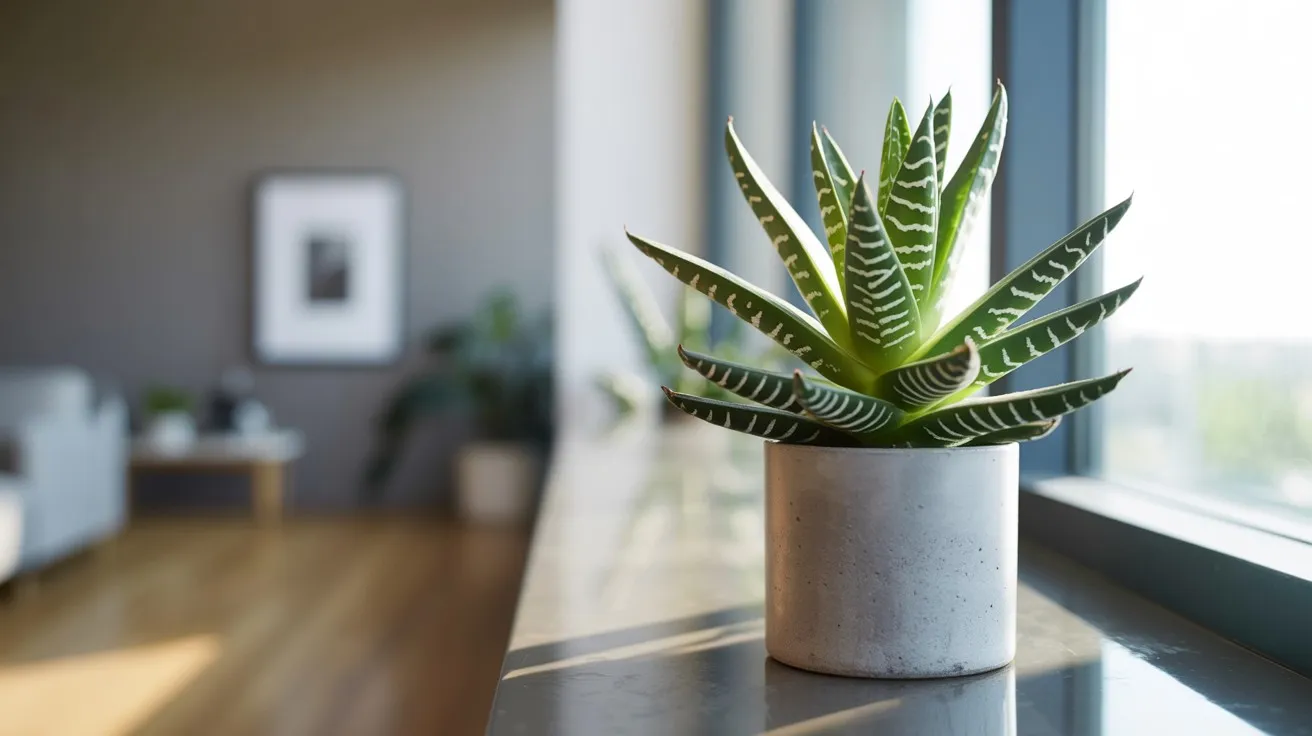Want a cool-looking plant that’s easy to care for and doesn’t die on you in a week? That’s where the Zebra Plant comes in. If you’re new to houseplants or just want something low-fuss, learning proper zebra plant care is the perfect place to start.
The Zebra Plant, also known as Haworthiopsis fasciata, is a small succulent with sharp, thick green leaves and white stripes across them—just like a zebra. These leaves hold water inside, so the plant doesn’t need much watering. That’s one reason why zebra plant care is simple and ideal for beginners.
It originally comes from South Africa, where it grows in dry, rocky places. That tells you a lot about how to care for it: not too much water, some sunlight, and a small pot. It belongs to the Asphodelaceae family, the same family as Aloe Vera—another tough little survivor. One great tip in zebra plant care is to mimic its natural desert-like conditions.
Now, don’t confuse it with Aphelandra squarrosa, another plant called Zebra Plant. That one is tropical, hard to manage, and totally different. We’re only talking about the succulent Zebra Plant here—the chill, beginner-friendly one.
Why does this matter? Because knowing what kind of plant you have helps you give it what it really needs. You don’t need fancy tools or expert skills—just a little light, occasional water, and the right soil. Good zebra plant care keeps the plant happy and thriving for months, even years.
If you’re ready to learn more about keeping your plant healthy, this zebra plant care guide will walk you through everything step by step.
Table of Contents
ToggleHow to Grow Zebra Plant Indoors (Complete Care Guide)
If you’re trying to master zebra plant care, the first thing to know is this: it’s not hard, but it’s not a set-it-and-forget-it kind of plant either. When grown indoors, this small succulent with white-striped leaves can truly shine—but only if you meet its basic care needs. Whether you’re a beginner or someone looking to stop killing your succulents, this guide will help you grow it the right way.
Light Requirements: Indirect but Bright is Best
Zebra plant care requires attention to lighting, as the zebra plant doesn’t like direct sunlight. In its natural semi-shaded habitat, it thrives under filtered light—something you should try to mimic indoors. Place your plant near a window that offers plenty of light, but avoid direct rays. Bright, indirect light helps keep the leaves short, firm, and vibrant. Too much sunlight can burn the leaves, while too little causes them to stretch and lose their compact shape. If your space lacks sufficient light, especially during winter, using a grow light is a great way to maintain a healthy zebra plant.
Watering Schedule: Water Deeply, Not Frequently
One of the most important tips in zebra plant care is understanding its watering needs. Zebra plants store water in their thick leaves, so they don’t need watering often. In fact, overwatering is one of the fastest ways to kill the plant. The rule is simple—let the soil dry out completely between waterings. When you do water, soak it thoroughly until water drains out from the bottom, then leave it alone. Signs of overwatering include mushy leaves or blackened roots. If the plant looks wrinkled, it probably needs water, but don’t rush it—check the soil first. Stick to watering every few weeks, and you’ll avoid root rot and other common issues related to poor zebra plant care. Smart watering habits are a key part of successful zebra plant care at home.
Humidity and Temperature Needs: Stay Comfortable
Good zebra plant care means keeping the plant in a comfortable temperature range, similar to what people prefer. Zebra plants like temperatures between 65 to 80 degrees Fahrenheit. Avoid placing the plant near heaters, cold windows, or vents that blow dry air. When it comes to humidity, these plants are quite adaptable. Average indoor humidity levels usually work well. They don’t require misting or humidifiers like tropical plants, but extremely dry air can slow their growth. During winter, if you notice browning tips, it might be time to move your plant away from drafts or place a simple water tray nearby to balance the moisture. Paying attention to both temperature and humidity is an essential part of smart zebra plant care, especially in changing seasons. Stay consistent, and your efforts in zebra plant care will keep the plant healthy year-round.
Soil and Pot Type: Drainage is Everything
Good zebra plant care starts with the right soil. This plant hates soggy roots and needs a well-draining soil mix made especially for succulents or cacti. That kind of soil lets water flow through easily and dries fast, which is essential for proper zebra plant care. Using regular potting soil traps too much moisture, which can cause root rot and harm your plant. The choice of pot matters too—a terracotta pot is perfect because it helps absorb extra moisture, supporting healthy zebra plant care. Always use a pot with a drainage hole at the bottom. Plastic pots can work as well, but they hold more water, so be extra careful if you choose that type.
Fertilizer Use: Light Feeding for Healthy Growth
Proper zebra plant care means feeding your plant just right. Zebra plants don’t need a lot of fertilizer, but feeding them during the growing season can give them a healthy boost. Spring and summer are the best times to feed, using a diluted liquid fertilizer made especially for succulents, which is key for good zebra plant care. Avoid feeding in winter when the plant goes into rest mode. Over-fertilizing can damage the roots and cause leaf problems, so less is definitely more when it comes to proper zebra plant care. A gentle feed once every month or so during the active months is enough to keep your plant thriving.
Growth Timeline: Don’t Expect Instant Results
Patience is key in zebra plant care because this plant is a slow grower. It won’t shoot up overnight, and that’s completely normal. Zebra plants take their time, especially indoors. You’ll usually see new growth in the spring, but the pace is steady, not fast. With proper zebra plant care, the plant can live for years, staying compact and healthy. If you’re patient, you might even notice baby plants, called offsets, forming around the base. These can be separated and repotted to grow new zebra plants, making it a rewarding plant to care for over time with consistent zebra plant care.

Common Problems and How to Fix Them
Even with the best zebra plant care, things can sometimes go sideways. But don’t worry—most issues are easy to spot and fix once you know what to look for. Whether your zebra plant is getting soft, changing color, or just looking off, this guide will help you bring it back to life.
Leaves Turning Yellow, Curling, or Browning at the Tips
If you notice the leaves on your zebra plant (Haworthiopsis fasciata) turning yellow, curling inward, or drying out at the tips, your plant is sending a clear signal. These symptoms are usually caused by overwatering, underwatering, or dry indoor air. Yellowing often means the roots are sitting in too much water. Curling leaves might mean the plant is thirsty or stressed from heat or cold. Crispy brown tips show up when humidity is too low or the air is too dry from indoor heaters. Proper zebra plant care means paying close attention to these signs and adjusting watering and environment accordingly to keep your plant healthy. Good zebra plant care involves keeping your plant away from radiators, cold drafts, and windows that let in too much heat or chill. Maintaining a comfortable, stable environment goes a long way in preventing these issues and is an important part of successful zebra plant care.
Root Rot: A Silent Killer You Can Prevent
One of the most common problems in zebra plant care is root rot—and it happens fast if you water too often or use the wrong soil. The roots start turning black and mushy, and the plant may look soft or collapse from the base. This happens when water sits in the soil for too long without draining.
To save your plant, gently remove it from the pot and check the roots. Trim off any rotting parts using clean scissors. Repot it in well-draining succulent soil inside a pot with proper drainage holes. Then wait a few days before watering again. Always let the top inch of soil dry out completely between waterings to avoid this problem in the future.
Pests Like Mealybugs and Aphids
If you see small white fluff or sticky residue on your zebra plant, you might be dealing with mealybugs or aphids. These tiny pests feed on the plant’s sap, weakening it and sometimes causing new leaves to shrivel.
You can remove them using a mild soap solution—just mix a few drops of dish soap in water and gently wipe the leaves. For heavier infestations, spray with neem oil or a natural insecticidal soap. Always check the plant regularly, especially under the leaves and around the base, where pests like to hide. Proper zebra plant care includes regular inspection to keep your plant healthy.
Sunburn and Stretching: Signs of Light Trouble
Too much direct sunlight can burn the zebra plant’s leaves, causing them to turn pale or develop dry, white patches. On the other hand, too little light causes the plant to stretch, growing tall and leggy as it reaches for a light source.
For best results, place your plant in bright, indirect light. Near a north- or east-facing window usually works best. If natural light is limited, especially in winter, using a small grow light for succulents can help maintain healthy growth and color. Proper zebra plant care always includes giving it the right amount of light.
Reviving a Dying Zebra Plant
When your plant looks weak, soft, or discolored, it doesn’t always mean it’s beyond saving. First, check the soil moisture and roots. If it’s too wet and roots are mushy, trim the damaged roots and repot in dry soil. If it’s too dry, water it gently and wait for the leaves to firm up.
Make sure it’s in the right lighting conditions and not sitting in extreme temperatures. With patience, fresh soil, and the right watering habits, most zebra plant care routines can help your plant recover—even if it looks nearly gone.
How to Propagate Your Zebra Plant Successfully
One of the best ways to grow your zebra plant collection is through propagation. The easiest and most reliable method is by using offsets, also called pups. These are small baby plants that grow around the base of the main plant. When the pups have grown enough roots, you can carefully separate them from the parent plant and plant them in their own pots. This helps new zebra plants grow faster because they already have a strong root system.
Another way to propagate is by using leaf cuttings, but this takes longer and is a bit more delicate. For beginners, pups are the safest and fastest choice. The best time to propagate is during the plant’s active growing season in spring or early summer, when the temperature and light are perfect for new growth. Proper zebra plant care includes knowing when and how to propagate for healthy expansion.
Repotting Your Zebra Plant: When and How to Do It Right
Knowing when to repot your zebra plant is important to keep it healthy. If you see roots coming out of the drainage holes or the plant looks crowded, it’s time for a new pot. Choose a pot slightly bigger than the current one with good drainage holes to prevent water from sitting in the soil.
Use a fresh, well-draining succulent soil mix to help your plant thrive. When repotting, gently take out the plant, loosen the roots a little, and place it in the new pot. Fill the gaps with soil but don’t press it too hard. After repotting, give your plant a few days without watering to help it recover from transplant shock. Keep it in bright, indirect light and watch closely for any signs of stress.
For safe repotting and propagation, clean scissors or a small knife work well. Keeping tools clean is important to stop any diseases from spreading. Propagating and repotting not only help your zebra plant stay healthy but also let you grow new plants to share or enjoy around your home. Proper zebra plant care includes knowing when and how to repot and propagate for the best results.

Frequently Asked Questions (FAQs)
Can the Zebra Plant survive in low light?
Yes, the zebra plant (Haworthiopsis fasciata) can survive in low light, but it grows best in bright, indirect light. If the light is too low, the plant may grow slowly or stretch out, losing its beautiful striped leaves. Proper zebra plant care includes giving your plant the right amount of light to keep it healthy and vibrant.
Is Zebra Plant toxic to pets?
No, the zebra plant is generally considered non-toxic to cats and dogs. This makes it a safe choice if you have pets at home who like to nibble on plants. Including this fact in your routine zebra plant care ensures a pet-friendly environment while keeping your plant healthy.
How often should I fertilize my Zebra Plant?
Fertilize your zebra plant once a month during the growing season (spring and summer) using a balanced, water-soluble fertilizer diluted to half strength. Avoid fertilizing in winter when the plant is resting. Proper zebra plant care includes feeding your plant at the right time to support healthy growth.
Why is my Zebra Plant not growing?
If your zebra plant is not growing, it could be due to lack of light, improper watering, or nutrient deficiency. Make sure it gets enough indirect sunlight and water only when the soil is dry. Using fresh soil and proper fertilizer also helps. Consistent, attentive zebra plant care can restore healthy growth over time.
What is the best season to propagate Zebra Plant?
The best time to propagate your zebra plant is during spring or early summer. This is when the plant is actively growing, so new pups or cuttings will root and grow faster. Following seasonal timing is an important part of successful zebra plant care.
How long does a Zebra Plant live?
With proper care, a zebra plant can live for several years—sometimes over 5 to 10 years. Keeping the plant healthy with the right light, proper watering, and occasional repotting helps it live longer. Long-lasting zebra plant care means staying consistent with these simple routines.
Conclusion
The Zebra Plant (Haworthiopsis fasciata) is a great choice for anyone who wants a cool, easy-to-care-for houseplant. Its thick, striped leaves are not only beautiful but also store water, so it doesn’t need much attention. By giving your zebra plant the right amount of bright, indirect light, careful watering, and well-draining soil, you can keep it healthy and happy for many years. Remember, overwatering is the most common mistake, so always let the soil dry out before watering again. If you want to grow more plants, try propagating using offsets during spring or summer. With proper care and patience, your zebra plant will grow slowly but steadily, adding green charm to your home. Following this simple zebra plant care guide will help you avoid common problems and enjoy a thriving, vibrant plant that lasts a long time.



